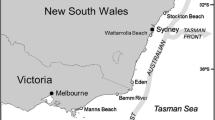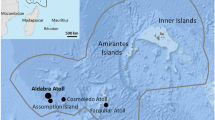Abstract
Using museum data of adult specimens whose sex, age, and locality are known, we studied temporal and geographical body size trends among the otter, Lutra lutra, in Norway. We found that body size of the otters increased during the last quarter of the twentieth century, and suggest that this trend is related to increased food availability from fish farming and possibly also to energy saving due to elevated sea temperatures. Birth year and death year explained 38.8 and 43.5%, respectively, of the variation in body size. Body size of otters was positively related to latitude, thus conforming to Bergmann’s rule.


Similar content being viewed by others
References
Anon (2005) Resources and environment of the sea 2005 (in Norwegian with English summary). Fisk Havet 2005:1
Aure J, Strand Ø (2001) Hydrographic normals and long-term variations at fixed surface layer stations along the Norwegian coast from 1936 to 2000 (in Norwegian with English subtitles and abstract). Fisk Havet 2001:13
Carss DN (1993) Shags Phalacrocorax aristotilis at cage fish farms in Argyll, Western Scotland. Bird Study 40:203–211
Dempster T, Sanchez-Jerez P, Bayle-Sepere J, Kingsford M (2004) Extensive aggregations of wild fish at coastal sea-cage fish farms. Hydrobiology 525:245–248
Esmark M, Stensland S, Lilleeng MS (2005) On the run—escaped farmed fish in Norwegian waters. WWF-Norway
Genner MJ, Simms DW, Waermouth VJ, Southall EJ, Southward AJ, Henderson PA Hawkins SJ (2004) Regional climatic warming drives long-term community changes of British marine fish. Proc R Soc Lond B 271:655–661
Gosler AG, Greenwood JJD, Perrins CM (1995) Predation risk and the cost of being fat. Nature 377:621–623
Grant PR, Grant BR (1995) Predicting microevolutionary responses to directional selection on heritable variation. Evolution 49:241–251
Hansen LP, Fiske P, Holm M, Jensen AJ, Sægrov H (2005) Population status for salmon in Norway 2004 (in Norwegian). Report from a working group. Utredning for DN 2005-4
Heggberget TM (1984) Age determination in the European otter Lutra lutra lutra. Zeit Säugetier 49:299–305
Heggberget TM (1995) Food resources and feeding ecology of marine feeding otters (Lutra lutra). In: Skjoldal HR, Hopkins C, Erikstad KE, Leinaas HP (eds) Ecology of fjords and coastal waters. Elsevier, Leiden, pp 609–618
Heggberget TM (1998) Life history and population dynamics in the Norwegian otter (in Norwegian with English abstract and legends to figures and tables). NINA Oppdragsmeld 569:1–40
Heggberget TM, Christensen H (1994) Reproductive timing in Eurasian otters on the coast of Norway. Ecography 17:339–348
Henry CJK, Ulijaszek SJ (1996) Long-term consequences of early environment. Cambridge University Press, Cambridge
IPCC (2001) Climate change 2001: synthesis report. In: Watson RT, the Core Writing Team (eds) A contribution of working groups I, II, and III to the third assessment report of the Intergovernmental Panel on Climate Change. Cambridge University Press, Cambridge, New York
Johansen R, Eliassen R (1999) Wildlife damage to farmed fish (in Norwegian with English abstract). Report for Nord-Trøndelag, Nordland, Troms and Finnmark. NF-rapport 6/99
King CM (1989) The advantages and disadvantages of small size to weasels, Mustela species. In: Gitelman JL (ed) Carnivore behaviour, ecology and evolution. Cornell University Press, Ithaca, N.Y., pp 302–334
Kruuk H (1995) Wild otters. Oxford University Press, Oxford
Kruuk H, Balharry D (1990) Effects of sea water on thermal insulation of the otter, Lutra lutra. J Zool Lond 220:405–415
Kruuk H, Conory JWH, Moorhouse A (1991) Recruitment to a population of otters in Shetland, in relation to fish abundance. J Appl Ecol 28:95–101
Kruuk H, Balharry E, Taylor PT (1994) Oxygen consumption of the Eurasian otter Lutra lutra in relation to water temperature. Physiol Zool 67:1174–1185
Lindstrom J (1999) Early development and fitness in birds and mammals. Trends Ecol Evol 14:343–348
Machias A, Karakassis I, Giannoulaki M, Papadopoulou KN, Smith CJ, Somarakis S (2005) Response of demersal fish communities to the presence of fish farms. Mar Ecol Prog Ser 288:241–250
Mayr E (1970) Population, species and evolution. Harvard University Press, Cambridge, Mass.
Read AJ, Gaskin DE (1990) Changes in growth and reproduction of harbour porpoises, Phocoena phocoena, from the Bay of Fundy. Can J Fish Aquat Sci 47:2158–2163
Reale D, McAdam AG, Boutin S, Berteaux D (2003) Genetic and plastic responses of a northern mammal to climate change. Proc R Soc Lond B 270:591–596
Schmidt-Nielsen K (1983) Animal physiology: adaptation and environment. Cambridge University Press, Cambridge
Sjøtun K (ed) (2004) The ocean environment 2004. Fisken og havet, særnr 2–2004. In Norwegian with English summary
Smith FA, Browning H, Shepherd UL (1998) The influence of climate change on the body mass of woodrats Neotoma in arid region of New Mexico, USA. Ecography 21:140–148
Ulijaszek SJ, Jonhston FE, Preece MA (1998) Human growth and development. Cambridge University Press, Cambridge
Yom-Tov Y (2001) Global warming and body mass decline in Israeli passerine birds. Proc R Soc Lond B 268:947–952
Yom-Tov Y (2003) Body sizes of carnivores commensal with humans have increased over the past 50 years. Funct Ecol 17:323–327
Yom-Tov Y, Yom-Tov S (2004) Climatic changes and body size in two species of Japanese rodents. Bio J Linn Soc 82:263–267
Yom-Tov Y, Yom-Tov J (2005) Global warming, Bergmann’s rule and body size in the masked shrew Sorex cinereus in Alaska. J Anim Ecol 74:803–808
Yom-Tov Y, Yom-Tov S, Baagøe HJ (2003) Increase of skull size in the red fox (Vulpes vulpes) and Eurasian badger (Meles meles) in Denmark during the 20th century: an effect of improved diet? Evol Ecol Res 5:1037–1048
Yom-Tov Y, Yom-Tov S, Wright J, Thorne CJR, Du Feu R (2006) Recent changes in body weight and wing length among some British passerine birds. Oikos 112:91–101
Acknowledgements
Y. Yom-Tov and S. Yom-Tov wish to thank Ann Karin Hufthammer and Tore Fredriksen for their help at Bergen Museum and Naomi Paz for English editing. We are grateful to Eli Geffen and Uzi Morto for their help and two anonymous referees for their very useful comments. This study was partially financed by the Israel Cohen Chair for Environmental Zoology to Y. Yom-Tov.
Author information
Authors and Affiliations
Corresponding author
Additional information
Communicated by Roland Brandl
Rights and permissions
About this article
Cite this article
Yom-Tov, Y., Heggberget, T.M., Wiig, Ø. et al. Body size changes among otters, Lutra lutra, in Norway: the possible effects of food availability and global warming. Oecologia 150, 155–160 (2006). https://doi.org/10.1007/s00442-006-0499-8
Received:
Accepted:
Published:
Issue Date:
DOI: https://doi.org/10.1007/s00442-006-0499-8




